Aviation Management and Logistics: Ratio Analysis & Benchmarking
VerifiedAdded on 2023/06/17
|7
|1559
|195
Report
AI Summary
This report provides a financial analysis of Emirates Airlines and compares its performance with Singapore Airlines and Lufthansa using ratio analysis. Key ratios such as unit cost, yield, load factor, break-even load factor, employee productivity, EBIT margin, debt/equity ratio, current ratio, and P/E ratio are calculated and compared. The report also discusses the benchmarking approach, including its types (internal, competitive, and industry benchmarking), advantages, and limitations. It concludes that while benchmarking helps identify areas for improvement, it doesn't provide solutions and may overlook micro and macro factors. The analysis indicates Emirates is performing well compared to its competitors amidst the Covid-19 pandemic.
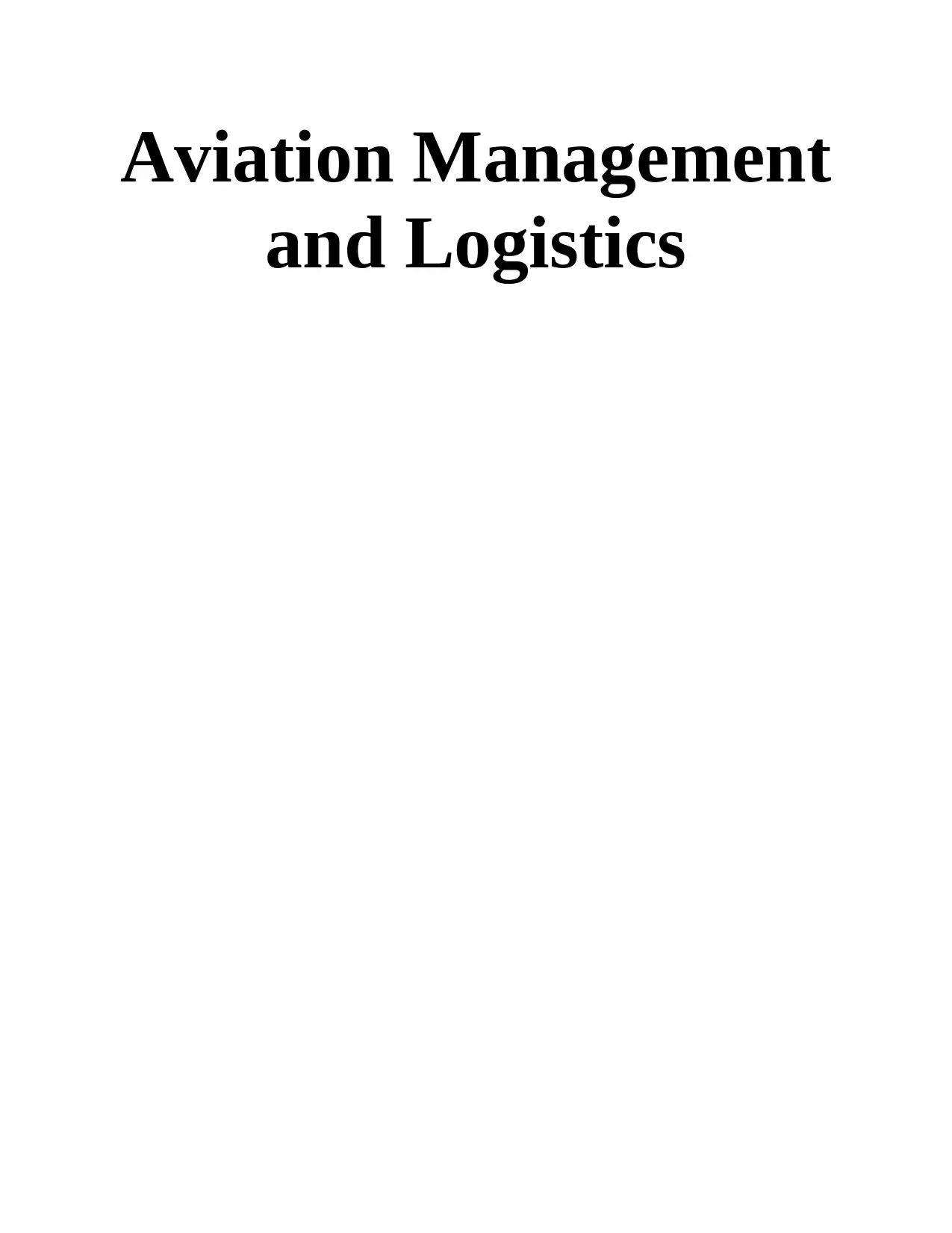
Aviation Management
and Logistics
and Logistics
Paraphrase This Document
Need a fresh take? Get an instant paraphrase of this document with our AI Paraphraser
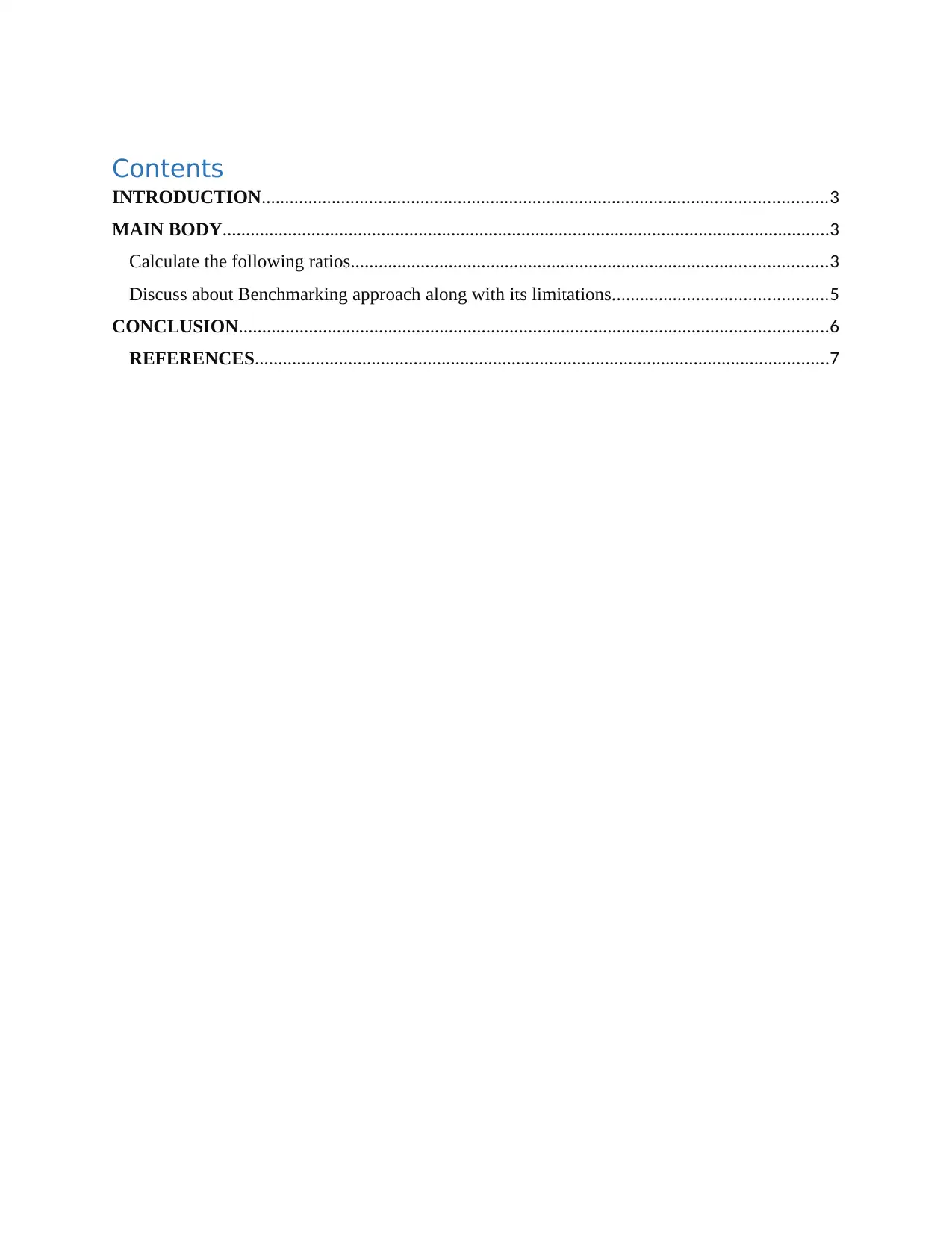
Contents
INTRODUCTION.........................................................................................................................3
MAIN BODY..................................................................................................................................3
Calculate the following ratios......................................................................................................3
Discuss about Benchmarking approach along with its limitations..............................................5
CONCLUSION..............................................................................................................................6
REFERENCES...........................................................................................................................7
INTRODUCTION.........................................................................................................................3
MAIN BODY..................................................................................................................................3
Calculate the following ratios......................................................................................................3
Discuss about Benchmarking approach along with its limitations..............................................5
CONCLUSION..............................................................................................................................6
REFERENCES...........................................................................................................................7

INTRODUCTION
Financial statements can be defined as a summarized report of position and performance
of the company. It provides a base to the users of this information to check out for the required
data for making their various organizational decisions. It is also useful for organizations to
analyze its asset value, profitability and capabilities. They also compare their own reports with
that of the other competing firms to stand in the market and create a separate space for
themselves. There are number of methods to analyze such as “ratio analysis “which helps in
fulfilling this purpose(Cimarelli, Leonforte and Angeli, 2019). The firm chosen in this report is
“Emirates Airlines “. it is an UAE based business firm in aviation industry. At present it is
operating in nearly eighty countries with around 300 air crafts. The report calculates various
ratios of different airline companies. It further analyzes their performances in comparison to
other firms. It also discusses about the limitations of benchmarking approach and steps involved
in it in context to IATA.
MAIN BODY
Calculate the following ratios
(a) Unit cost (per aircraft capacity) = operating expenses / total number of seat miles
produced
Emirates
2019 = 146
2020 = 141
Singapore Airlines
2019 = 50.5
2020 = 56.8
(b) Yield (per RPK and/or RTK) = Passenger revenue / available seat kilometers
Emirates
2019 = 219
2020 = 222
Singapore Airlines
2019 = 77
2020 = 74.6
Lufthansa
2019 = 26
2020 = 40.2
(c) Load factor = number of passengers / number of seats
Emirates
2019 = 66.8 %
2020 = 67.4 %
Singapore Airlines
Financial statements can be defined as a summarized report of position and performance
of the company. It provides a base to the users of this information to check out for the required
data for making their various organizational decisions. It is also useful for organizations to
analyze its asset value, profitability and capabilities. They also compare their own reports with
that of the other competing firms to stand in the market and create a separate space for
themselves. There are number of methods to analyze such as “ratio analysis “which helps in
fulfilling this purpose(Cimarelli, Leonforte and Angeli, 2019). The firm chosen in this report is
“Emirates Airlines “. it is an UAE based business firm in aviation industry. At present it is
operating in nearly eighty countries with around 300 air crafts. The report calculates various
ratios of different airline companies. It further analyzes their performances in comparison to
other firms. It also discusses about the limitations of benchmarking approach and steps involved
in it in context to IATA.
MAIN BODY
Calculate the following ratios
(a) Unit cost (per aircraft capacity) = operating expenses / total number of seat miles
produced
Emirates
2019 = 146
2020 = 141
Singapore Airlines
2019 = 50.5
2020 = 56.8
(b) Yield (per RPK and/or RTK) = Passenger revenue / available seat kilometers
Emirates
2019 = 219
2020 = 222
Singapore Airlines
2019 = 77
2020 = 74.6
Lufthansa
2019 = 26
2020 = 40.2
(c) Load factor = number of passengers / number of seats
Emirates
2019 = 66.8 %
2020 = 67.4 %
Singapore Airlines
⊘ This is a preview!⊘
Do you want full access?
Subscribe today to unlock all pages.

Trusted by 1+ million students worldwide
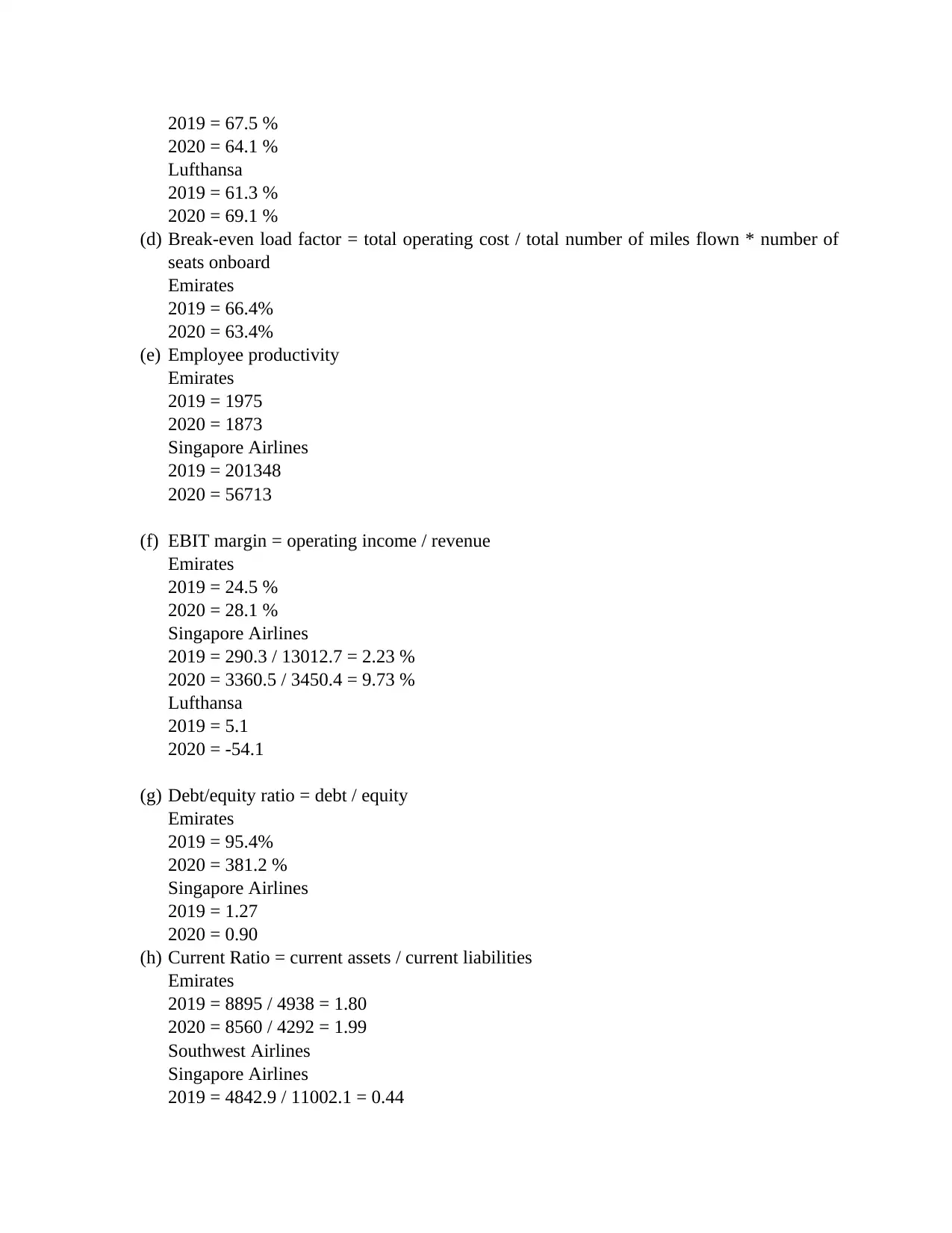
2019 = 67.5 %
2020 = 64.1 %
Lufthansa
2019 = 61.3 %
2020 = 69.1 %
(d) Break-even load factor = total operating cost / total number of miles flown * number of
seats onboard
Emirates
2019 = 66.4%
2020 = 63.4%
(e) Employee productivity
Emirates
2019 = 1975
2020 = 1873
Singapore Airlines
2019 = 201348
2020 = 56713
(f) EBIT margin = operating income / revenue
Emirates
2019 = 24.5 %
2020 = 28.1 %
Singapore Airlines
2019 = 290.3 / 13012.7 = 2.23 %
2020 = 3360.5 / 3450.4 = 9.73 %
Lufthansa
2019 = 5.1
2020 = -54.1
(g) Debt/equity ratio = debt / equity
Emirates
2019 = 95.4%
2020 = 381.2 %
Singapore Airlines
2019 = 1.27
2020 = 0.90
(h) Current Ratio = current assets / current liabilities
Emirates
2019 = 8895 / 4938 = 1.80
2020 = 8560 / 4292 = 1.99
Southwest Airlines
Singapore Airlines
2019 = 4842.9 / 11002.1 = 0.44
2020 = 64.1 %
Lufthansa
2019 = 61.3 %
2020 = 69.1 %
(d) Break-even load factor = total operating cost / total number of miles flown * number of
seats onboard
Emirates
2019 = 66.4%
2020 = 63.4%
(e) Employee productivity
Emirates
2019 = 1975
2020 = 1873
Singapore Airlines
2019 = 201348
2020 = 56713
(f) EBIT margin = operating income / revenue
Emirates
2019 = 24.5 %
2020 = 28.1 %
Singapore Airlines
2019 = 290.3 / 13012.7 = 2.23 %
2020 = 3360.5 / 3450.4 = 9.73 %
Lufthansa
2019 = 5.1
2020 = -54.1
(g) Debt/equity ratio = debt / equity
Emirates
2019 = 95.4%
2020 = 381.2 %
Singapore Airlines
2019 = 1.27
2020 = 0.90
(h) Current Ratio = current assets / current liabilities
Emirates
2019 = 8895 / 4938 = 1.80
2020 = 8560 / 4292 = 1.99
Southwest Airlines
Singapore Airlines
2019 = 4842.9 / 11002.1 = 0.44
Paraphrase This Document
Need a fresh take? Get an instant paraphrase of this document with our AI Paraphraser
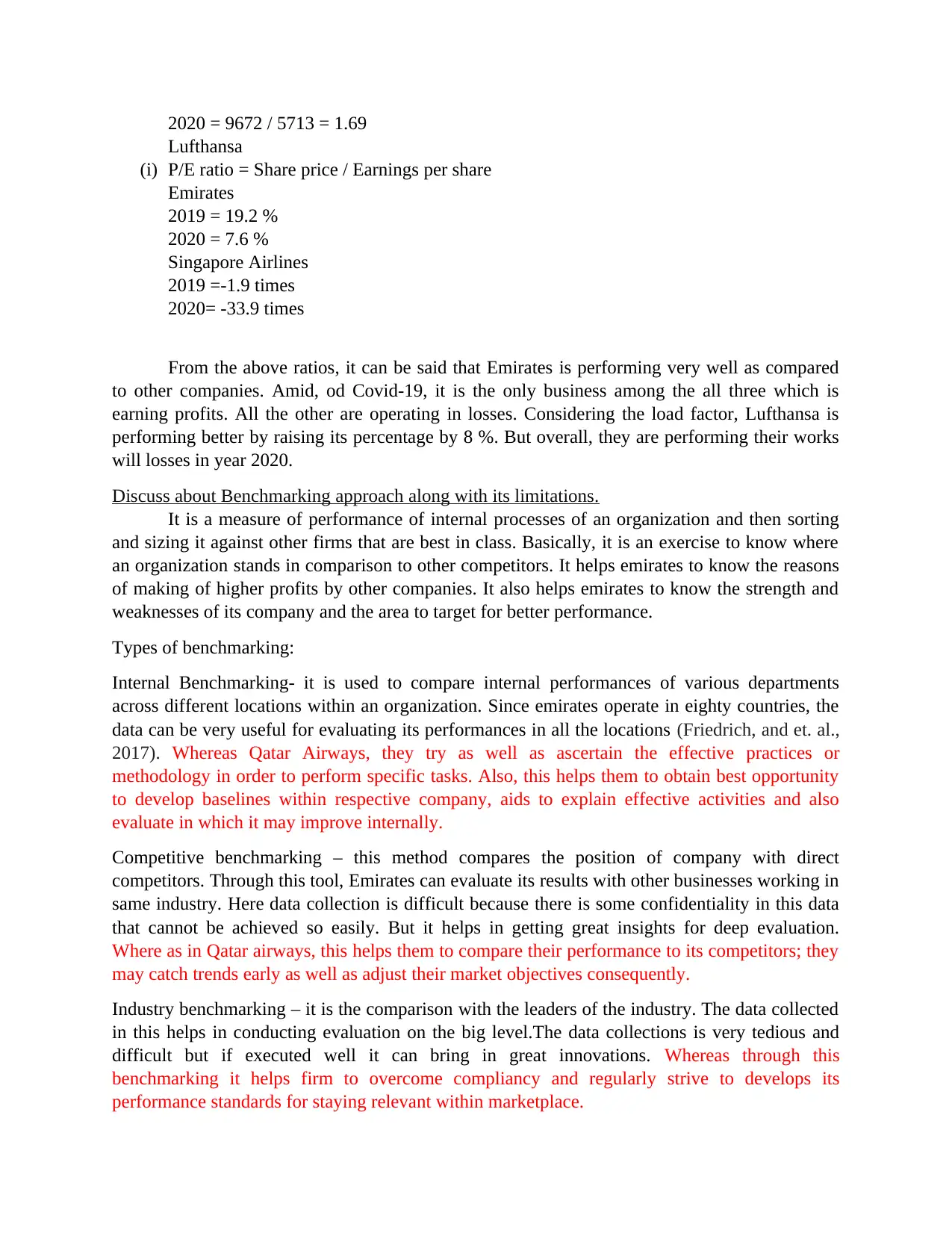
2020 = 9672 / 5713 = 1.69
Lufthansa
(i) P/E ratio = Share price / Earnings per share
Emirates
2019 = 19.2 %
2020 = 7.6 %
Singapore Airlines
2019 =-1.9 times
2020= -33.9 times
From the above ratios, it can be said that Emirates is performing very well as compared
to other companies. Amid, od Covid-19, it is the only business among the all three which is
earning profits. All the other are operating in losses. Considering the load factor, Lufthansa is
performing better by raising its percentage by 8 %. But overall, they are performing their works
will losses in year 2020.
Discuss about Benchmarking approach along with its limitations.
It is a measure of performance of internal processes of an organization and then sorting
and sizing it against other firms that are best in class. Basically, it is an exercise to know where
an organization stands in comparison to other competitors. It helps emirates to know the reasons
of making of higher profits by other companies. It also helps emirates to know the strength and
weaknesses of its company and the area to target for better performance.
Types of benchmarking:
Internal Benchmarking- it is used to compare internal performances of various departments
across different locations within an organization. Since emirates operate in eighty countries, the
data can be very useful for evaluating its performances in all the locations (Friedrich, and et. al.,
2017). Whereas Qatar Airways, they try as well as ascertain the effective practices or
methodology in order to perform specific tasks. Also, this helps them to obtain best opportunity
to develop baselines within respective company, aids to explain effective activities and also
evaluate in which it may improve internally.
Competitive benchmarking – this method compares the position of company with direct
competitors. Through this tool, Emirates can evaluate its results with other businesses working in
same industry. Here data collection is difficult because there is some confidentiality in this data
that cannot be achieved so easily. But it helps in getting great insights for deep evaluation.
Where as in Qatar airways, this helps them to compare their performance to its competitors; they
may catch trends early as well as adjust their market objectives consequently.
Industry benchmarking – it is the comparison with the leaders of the industry. The data collected
in this helps in conducting evaluation on the big level.The data collections is very tedious and
difficult but if executed well it can bring in great innovations. Whereas through this
benchmarking it helps firm to overcome compliancy and regularly strive to develops its
performance standards for staying relevant within marketplace.
Lufthansa
(i) P/E ratio = Share price / Earnings per share
Emirates
2019 = 19.2 %
2020 = 7.6 %
Singapore Airlines
2019 =-1.9 times
2020= -33.9 times
From the above ratios, it can be said that Emirates is performing very well as compared
to other companies. Amid, od Covid-19, it is the only business among the all three which is
earning profits. All the other are operating in losses. Considering the load factor, Lufthansa is
performing better by raising its percentage by 8 %. But overall, they are performing their works
will losses in year 2020.
Discuss about Benchmarking approach along with its limitations.
It is a measure of performance of internal processes of an organization and then sorting
and sizing it against other firms that are best in class. Basically, it is an exercise to know where
an organization stands in comparison to other competitors. It helps emirates to know the reasons
of making of higher profits by other companies. It also helps emirates to know the strength and
weaknesses of its company and the area to target for better performance.
Types of benchmarking:
Internal Benchmarking- it is used to compare internal performances of various departments
across different locations within an organization. Since emirates operate in eighty countries, the
data can be very useful for evaluating its performances in all the locations (Friedrich, and et. al.,
2017). Whereas Qatar Airways, they try as well as ascertain the effective practices or
methodology in order to perform specific tasks. Also, this helps them to obtain best opportunity
to develop baselines within respective company, aids to explain effective activities and also
evaluate in which it may improve internally.
Competitive benchmarking – this method compares the position of company with direct
competitors. Through this tool, Emirates can evaluate its results with other businesses working in
same industry. Here data collection is difficult because there is some confidentiality in this data
that cannot be achieved so easily. But it helps in getting great insights for deep evaluation.
Where as in Qatar airways, this helps them to compare their performance to its competitors; they
may catch trends early as well as adjust their market objectives consequently.
Industry benchmarking – it is the comparison with the leaders of the industry. The data collected
in this helps in conducting evaluation on the big level.The data collections is very tedious and
difficult but if executed well it can bring in great innovations. Whereas through this
benchmarking it helps firm to overcome compliancy and regularly strive to develops its
performance standards for staying relevant within marketplace.
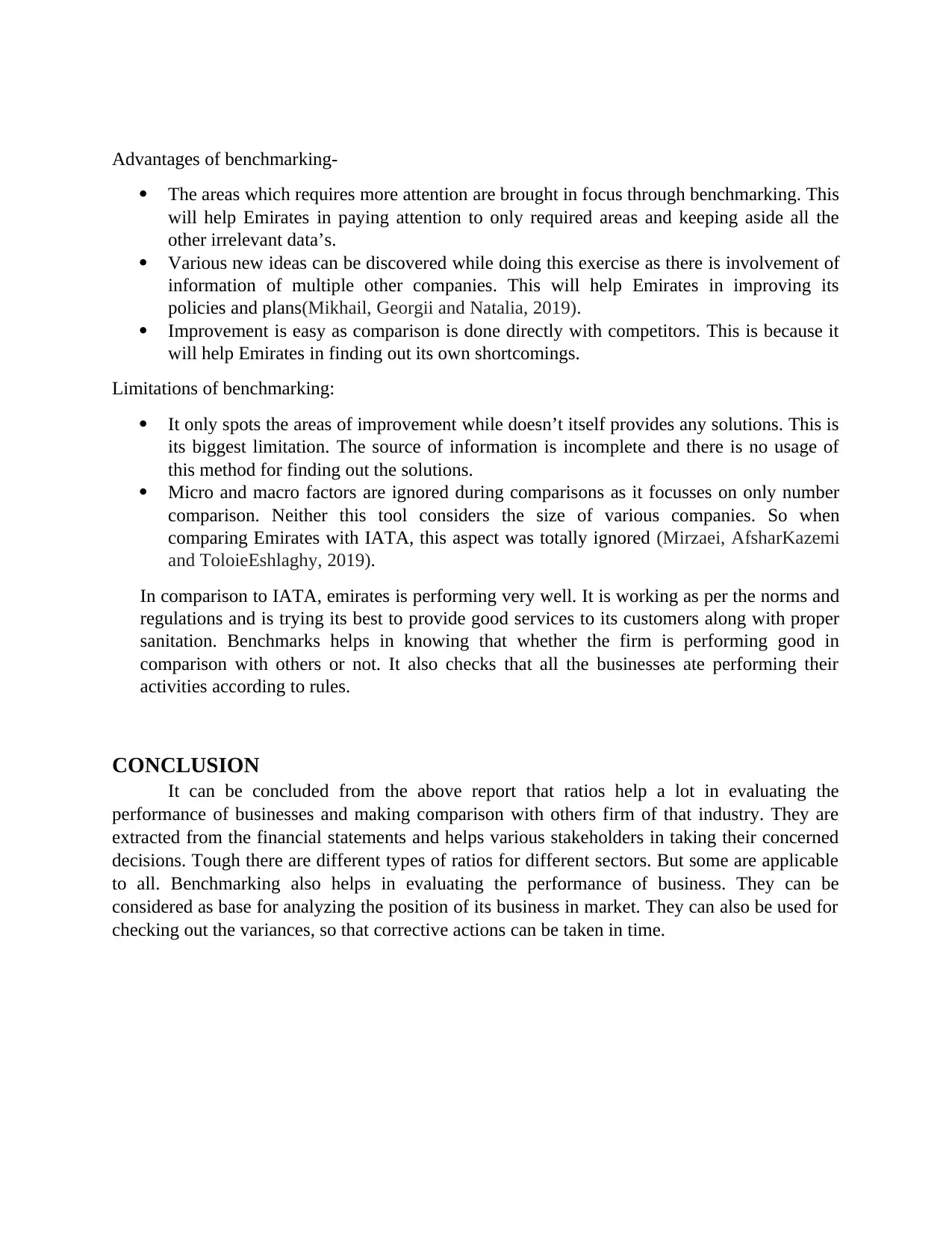
Advantages of benchmarking-
The areas which requires more attention are brought in focus through benchmarking. This
will help Emirates in paying attention to only required areas and keeping aside all the
other irrelevant data’s.
Various new ideas can be discovered while doing this exercise as there is involvement of
information of multiple other companies. This will help Emirates in improving its
policies and plans(Mikhail, Georgii and Natalia, 2019).
Improvement is easy as comparison is done directly with competitors. This is because it
will help Emirates in finding out its own shortcomings.
Limitations of benchmarking:
It only spots the areas of improvement while doesn’t itself provides any solutions. This is
its biggest limitation. The source of information is incomplete and there is no usage of
this method for finding out the solutions.
Micro and macro factors are ignored during comparisons as it focusses on only number
comparison. Neither this tool considers the size of various companies. So when
comparing Emirates with IATA, this aspect was totally ignored (Mirzaei, AfsharKazemi
and ToloieEshlaghy, 2019).
In comparison to IATA, emirates is performing very well. It is working as per the norms and
regulations and is trying its best to provide good services to its customers along with proper
sanitation. Benchmarks helps in knowing that whether the firm is performing good in
comparison with others or not. It also checks that all the businesses ate performing their
activities according to rules.
CONCLUSION
It can be concluded from the above report that ratios help a lot in evaluating the
performance of businesses and making comparison with others firm of that industry. They are
extracted from the financial statements and helps various stakeholders in taking their concerned
decisions. Tough there are different types of ratios for different sectors. But some are applicable
to all. Benchmarking also helps in evaluating the performance of business. They can be
considered as base for analyzing the position of its business in market. They can also be used for
checking out the variances, so that corrective actions can be taken in time.
The areas which requires more attention are brought in focus through benchmarking. This
will help Emirates in paying attention to only required areas and keeping aside all the
other irrelevant data’s.
Various new ideas can be discovered while doing this exercise as there is involvement of
information of multiple other companies. This will help Emirates in improving its
policies and plans(Mikhail, Georgii and Natalia, 2019).
Improvement is easy as comparison is done directly with competitors. This is because it
will help Emirates in finding out its own shortcomings.
Limitations of benchmarking:
It only spots the areas of improvement while doesn’t itself provides any solutions. This is
its biggest limitation. The source of information is incomplete and there is no usage of
this method for finding out the solutions.
Micro and macro factors are ignored during comparisons as it focusses on only number
comparison. Neither this tool considers the size of various companies. So when
comparing Emirates with IATA, this aspect was totally ignored (Mirzaei, AfsharKazemi
and ToloieEshlaghy, 2019).
In comparison to IATA, emirates is performing very well. It is working as per the norms and
regulations and is trying its best to provide good services to its customers along with proper
sanitation. Benchmarks helps in knowing that whether the firm is performing good in
comparison with others or not. It also checks that all the businesses ate performing their
activities according to rules.
CONCLUSION
It can be concluded from the above report that ratios help a lot in evaluating the
performance of businesses and making comparison with others firm of that industry. They are
extracted from the financial statements and helps various stakeholders in taking their concerned
decisions. Tough there are different types of ratios for different sectors. But some are applicable
to all. Benchmarking also helps in evaluating the performance of business. They can be
considered as base for analyzing the position of its business in market. They can also be used for
checking out the variances, so that corrective actions can be taken in time.
⊘ This is a preview!⊘
Do you want full access?
Subscribe today to unlock all pages.

Trusted by 1+ million students worldwide
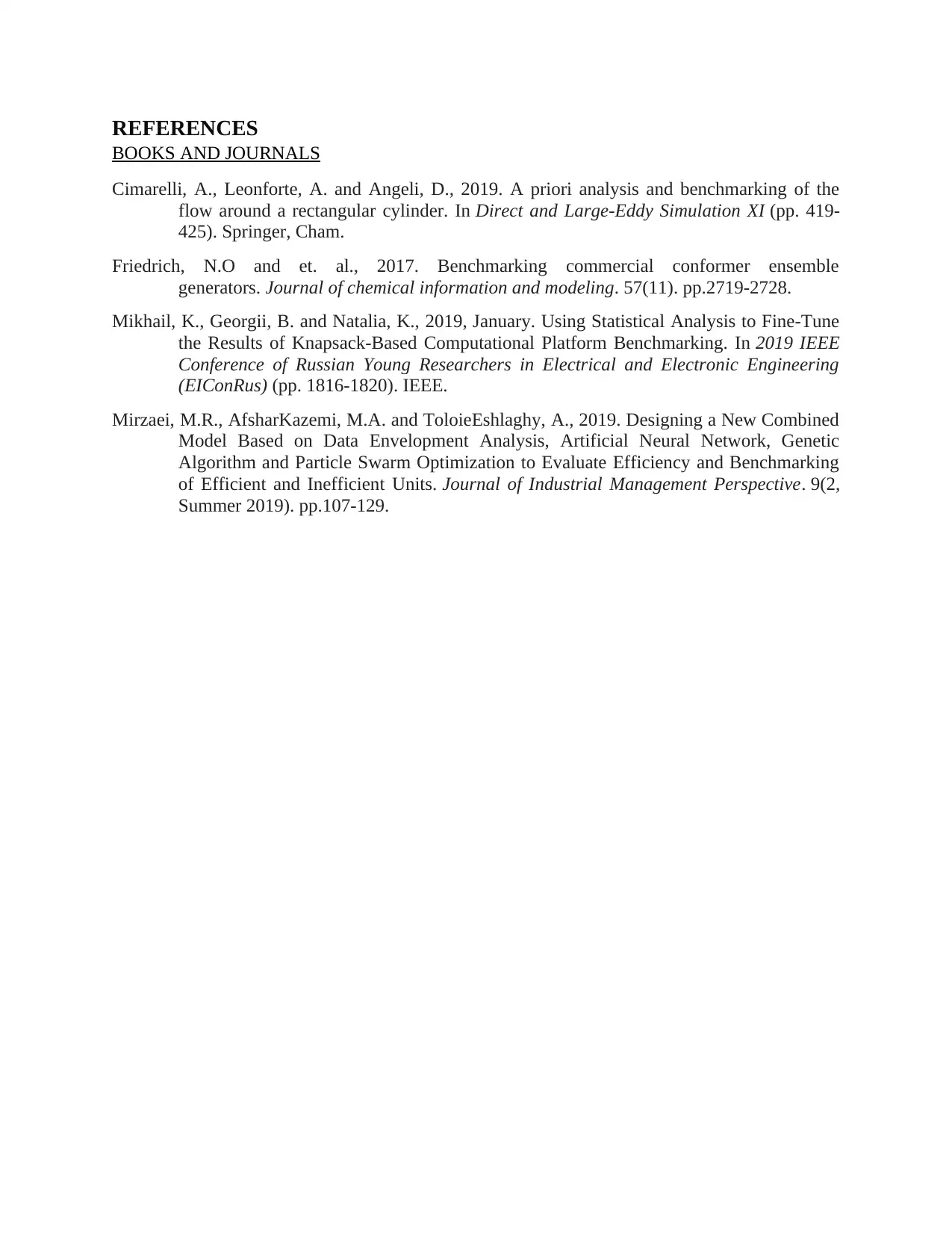
REFERENCES
BOOKS AND JOURNALS
Cimarelli, A., Leonforte, A. and Angeli, D., 2019. A priori analysis and benchmarking of the
flow around a rectangular cylinder. In Direct and Large-Eddy Simulation XI (pp. 419-
425). Springer, Cham.
Friedrich, N.O and et. al., 2017. Benchmarking commercial conformer ensemble
generators. Journal of chemical information and modeling. 57(11). pp.2719-2728.
Mikhail, K., Georgii, B. and Natalia, K., 2019, January. Using Statistical Analysis to Fine-Tune
the Results of Knapsack-Based Computational Platform Benchmarking. In 2019 IEEE
Conference of Russian Young Researchers in Electrical and Electronic Engineering
(EIConRus) (pp. 1816-1820). IEEE.
Mirzaei, M.R., AfsharKazemi, M.A. and ToloieEshlaghy, A., 2019. Designing a New Combined
Model Based on Data Envelopment Analysis, Artificial Neural Network, Genetic
Algorithm and Particle Swarm Optimization to Evaluate Efficiency and Benchmarking
of Efficient and Inefficient Units. Journal of Industrial Management Perspective. 9(2,
Summer 2019). pp.107-129.
BOOKS AND JOURNALS
Cimarelli, A., Leonforte, A. and Angeli, D., 2019. A priori analysis and benchmarking of the
flow around a rectangular cylinder. In Direct and Large-Eddy Simulation XI (pp. 419-
425). Springer, Cham.
Friedrich, N.O and et. al., 2017. Benchmarking commercial conformer ensemble
generators. Journal of chemical information and modeling. 57(11). pp.2719-2728.
Mikhail, K., Georgii, B. and Natalia, K., 2019, January. Using Statistical Analysis to Fine-Tune
the Results of Knapsack-Based Computational Platform Benchmarking. In 2019 IEEE
Conference of Russian Young Researchers in Electrical and Electronic Engineering
(EIConRus) (pp. 1816-1820). IEEE.
Mirzaei, M.R., AfsharKazemi, M.A. and ToloieEshlaghy, A., 2019. Designing a New Combined
Model Based on Data Envelopment Analysis, Artificial Neural Network, Genetic
Algorithm and Particle Swarm Optimization to Evaluate Efficiency and Benchmarking
of Efficient and Inefficient Units. Journal of Industrial Management Perspective. 9(2,
Summer 2019). pp.107-129.
1 out of 7
Related Documents
Your All-in-One AI-Powered Toolkit for Academic Success.
+13062052269
info@desklib.com
Available 24*7 on WhatsApp / Email
![[object Object]](/_next/static/media/star-bottom.7253800d.svg)
Unlock your academic potential
Copyright © 2020–2025 A2Z Services. All Rights Reserved. Developed and managed by ZUCOL.





